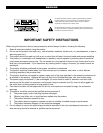
1. POWER Switch with LED Indicator
This switches the AC power ON or OFF. The integrated
LED will light to indicate power ON.
Note: In order to avoid possible undesired noise transients
in a live sound reinforcement application, switch on the
power to your MSE-100A before switching on the amplifi-
cation system.
2. IN/OUT Buttons and LED Indicators
The IN/OUT button activates the corresponding channel
into operation. With the button in the OUT position, the unit
is bypassed. The green LED will light to indicate “IN” and
the red LED will indicate “OUT”.
Bass Processor
The Enhancer is equipped with a separate bass processor
which provides sound enhancement in the lower frequency
band. A newly developed “Dual Mode” circuit allows you to
vary between two different bass sounds, from “soft” to
“tight”. Processing the bass range allows the optimum
complement to high-frequency processing and opens up
new dimensions in the field of sound processing.
3. LOW MIX Control
The LOW MIX control of the low band determines the
amount of signal used for sound enhancement (from zero
to six). The setting depends on the application you are
addressing.
4. MODE Buttons
With the MODE button you can define the sound effect of
the bass processor. If the button is on (“TIGHT”) the bass
will sound “dry” and “punchy”, whereas the released switch
mode (“SOFT”) creates a warm and full bass. The yellow
LED will indicate “TIGHT”.
Note: That the bass processor should be set carefully to
avoid possible speaker damage. Most near-field monitors
are not capable of handling the bass produced by the
Enhancer.
Multiband Processor With Variable Sound
Processing Circuit
The Variable Sound Processing circuit allows for variably
fading over from Enhancer to Exciter mode. Turning the
PROCESS control clockwise activates the Exciter circuit
increasingly to provide additional processing of high fre-
quencies for more signal transparency and brilliance.
Fading over from one effect to the other can thus adapt the
effects perfectly to the respective program material to suit
any application or personal sound preference.
5. TUNE control
The TUNE control sets the lower cutoff frequency of the
high-pass filter. Using this control you can select the fre-
quencies that are routed to the Natural Sonic Processor.
The cut-off frequency can be adjusted within a range of 1
to 8 kHz.
6. PROCESS control
The PROCESS control determines the function of the
device. Turning the control clockwise increasingly acti-
vates the Exciter mode.
Note: That for input signals that already include sufficient
treble content, such as classical music or acoustic instru-
ments, generally the setting should emphasize the Exciter
mode. However, when processing, for instance, a
“slapped” bass guitar, the “Exciter” setting should domi-
nate. Experiment for the sound you like.
7. HIGH MIX control
The HIGH MIX control of the high band determines the
amount of signal used for sound enhancement (from zero
to six). It would depend on the application as to whether a
high-quality system is to be given the “finishing touch” with
the Enhancer, or whether maximum intelligibility is to be
achieved in a relatively poor sound reinforcement system.
8. SURROUND IN/OUT Button
This button activates the SURROUND section. As this
mode is designed only for stereo applications, note that
this button has to be released when processing two sepa-
rate signals (dual mono) otherwise there will be undesired
crosstalk between the two channels. The green LED indi-
cates “IN”.
9. SURROUND Control
This controls the effect of the SURROUND processor (zero
to six). Turning the control clockwise improves the intensity
of the stereo imaging and increases the spatial enhance-
ment, depending on the signal being processed. It can only
be used with stereo program material.
FRONT PANEL CONTROLS AND CONNECTIONS
2
3
4
5 6
7 1
8
9
2
3
4
5 6
7
6












